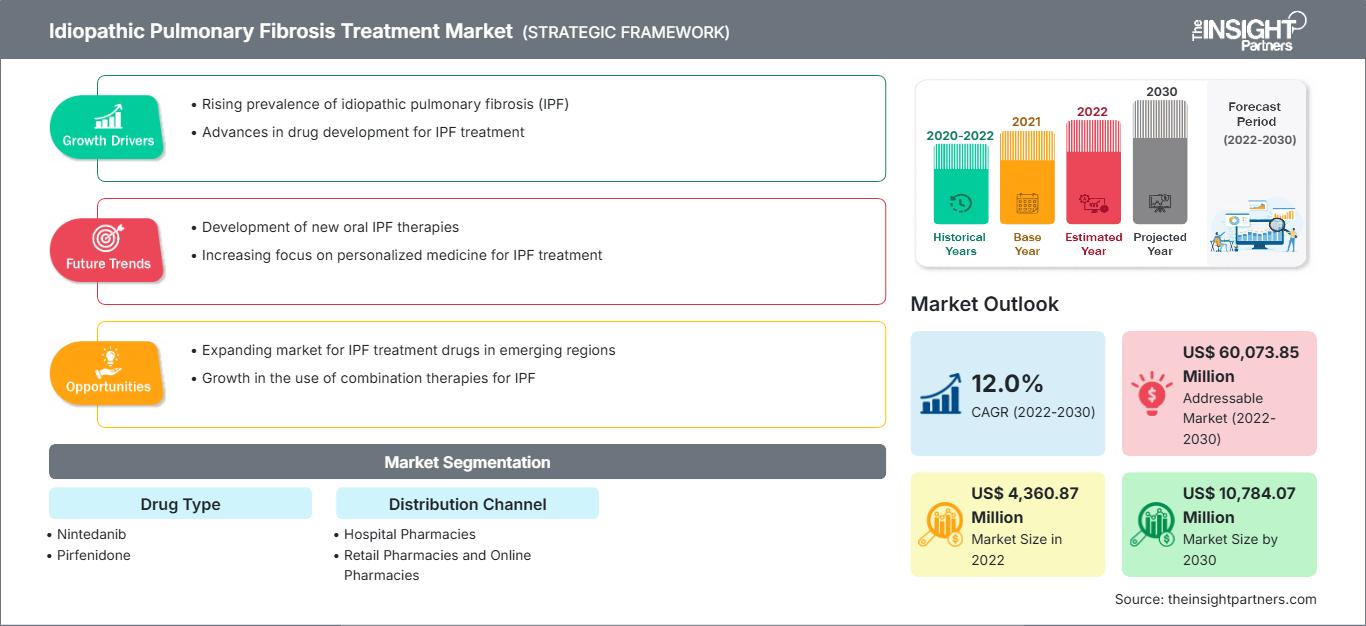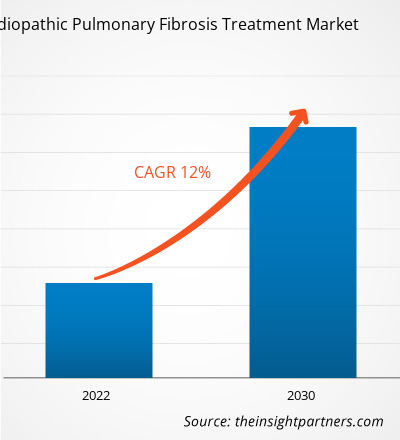[研究报告] 特发性肺纤维化治疗市场规模预计将从2022年的43.6087亿美元飙升至2030年的107.8407亿美元;预计2022年至2030年期间的复合年增长率为12.0%。
分析师观点:
特发性肺纤维化是一种影响肺泡周围组织的慢性疾病。当肺组织因不明原因变得僵硬和增厚时,就会发生这种情况,这些变化会随着时间的推移导致肺部永久性瘢痕形成,导致患者呼吸困难。目前,特发性肺纤维化尚无精准治疗方法。肺部康复、药物治疗和外科手术等治疗可以减缓肺部损伤,并有助于提高患者的生活质量。
特发性肺纤维化患病率的不断上升以及吸烟人数的不断增加,推动了未来几年对有效治疗药物的需求。正在进行的针对特发性肺纤维化治疗的有效药物研发工作,未来可能会进一步促进市场发展。目前,发达市场和新兴市场的医疗保健支出都在增长,预计这将鼓励该市场的制造商集中精力开发新的创新产品。
市场概览:
纤维化是指在正常愈合过程中发生的结缔组织沉积,或是在病理过程中发生的多余组织沉积。特发性肺纤维化会影响肺部和肺泡(肺泡)中的结缔组织。这种疾病可能会导致人们在日常活动中出现呼吸困难,而对于身体健康的人来说,日常活动并不令人感到疲劳。特发性肺纤维化治疗市场的增长归因于纤维化疾病负担的增加以及吸烟人数的激增。快速发展的研发活动推动了治疗技术的进步,预计将在未来几年为特发性肺纤维化治疗市场带来增长机会。
自定义此报告以满足您的要求
您将免费获得任何报告的定制,包括本报告的部分内容,或国家级分析、Excel 数据包,以及为初创企业和大学提供超值优惠和折扣
特发性肺纤维化治疗市场: 战略洞察

-
获取本报告的主要市场趋势。这个免费样本将包括数据分析,从市场趋势到估计和预测。
市场驱动因素:
特发性肺纤维化负担加重推动特发性肺纤维化治疗市场发展
根据美国肺脏协会 2022 年 11 月更新的数据,美国每年约有 50,000 例特发性肺纤维化新病例被诊断出来。这种疾病的症状在 50-70 岁的患者中更为明显。根据 2022 年 9 月发表在《英国医学杂志》上的一篇文章,2021 年专科护理单位中特发性肺纤维化的估计患病率为每 100,000 人 36.0 人。由于衰老、肥胖、高血压或家族史等常见风险因素,全球范围内患有特发性肺纤维化的患者数量正在增加,并且该疾病正在成为各经济体的沉重社会经济负担。因此,特发性肺纤维化患者数量的增加推动了纤维化疾病治疗市场的增长。
细分分析:
根据药物类型,特发性肺纤维化治疗市场细分为尼达尼布、吡非尼酮和其他药物。尼达尼布细分市场在2022年占据了更大的市场份额。预计其他细分市场在2022年至2030年期间的复合年增长率将高达46.3%。吡非尼酮和尼达尼布是治疗纤维化疾病的常用药物。
区域分析:
北美在全球特发性肺纤维化治疗市场中占据主导地位。2022 年北美市场价值为 23.6295 亿美元,预计到 2030 年将达到 55.2728 亿美元;预计 2022 年至 2030 年期间的复合年增长率为 11.2%。北美特发性肺纤维化治疗市场分为美国、加拿大和墨西哥。特发性肺纤维化负担的增加和治疗技术的进步使北美特发性肺纤维化治疗市场受益。主要市场参与者的产品发布和战略举措也促进了市场增长。随着特发性肺纤维化治疗研发活动的不断增多,改良药物不断涌入市场,从而为更广泛的患者群体带来了更便捷的用药途径。此外,该地区获得美国食品药品监督管理局(FDA)的广泛批准,也鼓励企业推出技术先进的产品。
随着特发性肺纤维化患病率的上升和高昂的医疗支出,欧洲在全球纤维化疾病治疗市场中占据第二大份额。由于德国在医疗保健领域更容易获得技术先进的产品和服务,预计它将在欧洲特发性肺纤维化治疗市场中占据主导地位。
预计亚太地区将在2022年至2030年期间在全球特发性肺纤维化治疗市场中实现最快的复合年增长率。预计的市场增长得益于尖端技术的广泛接受和采用,这些技术能够在显著缩短的时间内提供准确的结果。亚太地区的医疗保健行业正在利用人工智能、自动化和数字化转型方面的创新,提高医疗专业人员的效率和生产力。各行各业的持续转型增强了亚太地区的企业和经济实力,使它们能够以充满活力和前瞻性的方式,实现可持续发展,成为发展最快的中心。
关键参与者分析:
特发性肺纤维化治疗市场分析基于基因泰克公司 (Genentech, Inc.) 和勃林格殷格翰国际有限公司 (Boehringer Ingelheim International GmbH) 等关键参与者。
特发性肺纤维化治疗市场区域洞察
The Insight Partners 的分析师已详尽阐述了预测期内影响特发性肺纤维化治疗市场的区域趋势和因素。本节还讨论了北美、欧洲、亚太地区、中东和非洲以及南美和中美洲的特发性肺纤维化治疗市场细分和地域分布。
特发性肺纤维化治疗市场报告范围
| 报告属性 | 细节 |
|---|---|
| 市场规模 2022 | US$ 4,360.87 Million |
| 市场规模 2030 | US$ 10,784.07 Million |
| 全球复合年增长率 (2022 - 2030) | 12.0% |
| 历史数据 | 2020-2022 |
| 预测期 | 2022-2030 |
| 涵盖的领域 |
By 药物类型
|
| 覆盖地区和国家 |
北美
|
| 市场领导者和主要公司简介 |
|
特发性肺纤维化治疗市场参与者密度:了解其对业务动态的影响
特发性肺纤维化治疗市场正在快速增长,这得益于终端用户需求的不断增长,而这些需求的驱动因素包括消费者偏好的演变、技术进步以及对产品益处的认知度的提升。随着需求的增长,企业正在扩展产品线,不断创新以满足消费者需求,并抓住新兴趋势,从而进一步推动市场增长。

- 获取 特发性肺纤维化治疗市场 主要参与者概述
最新进展:
特发性肺纤维化治疗市场中的公司普遍采用并购等外部并购策略。以下列举一些最新进展:
- 2023年5月,勃林格殷格翰启动了突破性IL-11抑制剂抗体BI 765423的临床开发。1期临床试验(NCT05658107)重点评估了该药物在健康志愿者中的安全性、耐受性和药代动力学。临床前研究表明,这种抗 IL-11 药物在抑制和潜在逆转各种纤维化病例中的纤维化方面取得了良好的效果。
- 2022 年 10 月,勃林格殷格翰在 FIBRONEER-IPF III 期研究中招募了第一位美国患者,以评估 BI 1015550。BI 1015550 是一种实验性磷酸二酯酶 4B (PDE4B) 抑制剂,用于治疗患有特发性肺纤维化的患者。该研究是全球 FIBRONEER 项目的一部分,该项目包含两项 III 期研究:针对特发性肺纤维化患者的 FIBRONEER-IPF 和针对患有其他进行性纤维化间质性肺病 (ILD) 的成人患者的 FIBRONEER-ILD。
- 2022 年 9 月,Bellerophon Therapeutics, Inc. 宣布,FDA 接受了其目前正在进行的 REBUILD III 期注册试验 INOpulse 的试验规模缩减申请,该试验用于治疗纤维化间质性肺病 (LD)。
- 2022 年 5 月,全球领先的药物安全解决方案提供商 ArisGlobal 收购了勃林格殷格翰的 BRASS 数字创新技术。此次收购使 ArisGlobal 能够通过将 BRASS 集成到 LifeSphere Clarity 中来增强其 LifeSphere 技术平台。此次整合促进了整个行业药物警戒和患者安全的进步。此外,ArisGlobal 还在全球多个地区拓展了其临床诊断业务,巩固了其全球地位。
- 2022 年 3 月,领先的制药公司百时美施贵宝宣布通过最终合并协议以每股 76.00 美元的价格收购 Turning Point Therapeutics, Inc.。此次收购显著增强了百时美施贵宝在全球制药市场的影响力,使其能够更积极地为行业带来创新,同时扩展其拯救生命的疗法和治疗方案组合。
- 历史分析(2 年)、基准年、预测(7 年)及复合年增长率
- PEST和SWOT分析
- 市场规模、价值/数量 - 全球、区域、国家
- 行业和竞争格局
- Excel 数据集
近期报告
客户评价
购买理由
- 明智的决策
- 了解市场动态
- 竞争分析
- 客户洞察
- 市场预测
- 风险规避
- 战略规划
- 投资论证
- 识别新兴市场
- 优化营销策略
- 提升运营效率
- 顺应监管趋势






















 获取免费样品 - 特发性肺纤维化治疗市场
获取免费样品 - 特发性肺纤维化治疗市场